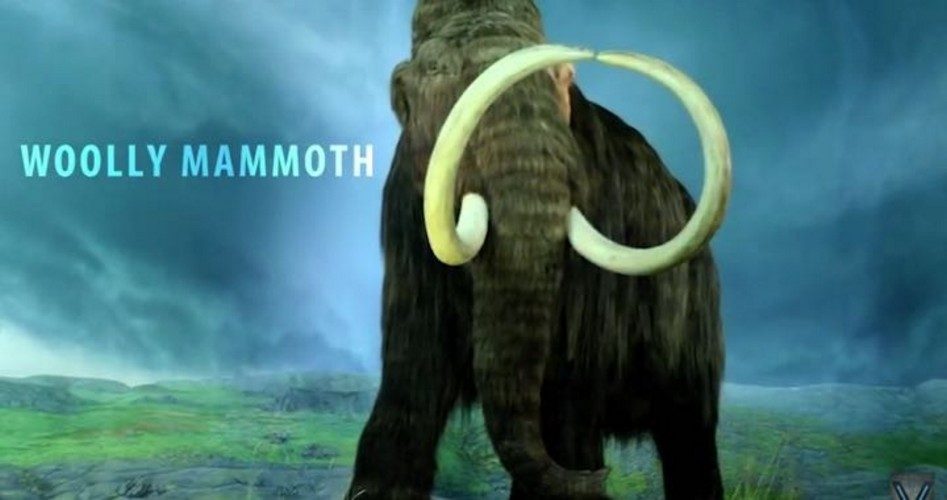
Just when you think climate alarmists couldn’t be more ridiculous, they surprise you, and plan things even more absurd than painting streets white to combat global warming. Looking to revitalize grassland in a Siberian steppe region, scientists there are hoping that geneticists at Harvard can create a mammoth-elephant hybrid — a “mammophant” — in the hope of reinvigorating the permafrost, which will slow down supposed global warming.
No word yet on whether Ray Romano will be giving voice to the creature.
Permafrost, which has remained frozen since the Pleistocene Era or Ice Age, contains large volumes of dormant carbon from dead plant life. Scientists believe that if this area melts, the trapped carbon may be an environmental time bomb, which upon thawing will release copious amounts of CO2 and methane, thus warming the Earth even more quickly than some scientists claim it is warming.
The theory goes that during the Ice Age, mammoths and other large herbivores roamed these steppe regions, uprooting trees, trampling mosses and shrubs, and generally disturbing the landscape. Some geophysicists think that they acted as natural geo-engineers with their activities, keeping the steppe lands productive and tree-less. Since grass absorbs less sunlight than trees, using mammoths as natural lumberjacks could theoretically slow down any thawing of the permafrost, which would lessen the impact of the dormant carbon on the atmosphere.
“Our aim is to produce a hybrid elephant-mammoth embryo,” said geneticist and molecular engineer Professor George Church of the Harvard team. “Actually, it would be more like an elephant with a number of mammoth traits. We’re not there yet, but it could happen in a couple of years.”
Besides saving the climate from carbon trapped in the permafrost, the gene manipulation may save the endangered Asian elephant, albeit in a modified form. Since the project began in 2015, the number of genetic “edits” where mammoth DNA has been spliced into the elephant genome has grown from 15 to 45.
“We already know about ones to do with small ears, subcutaneous fat, hair and blood, but there are others that seem to be positively selected,” Church said.
If they are able to recreate a hybrid mammoth, the scientists hope to release the new creatures into Pleistocene Park in northeastern Siberia. Since 1996, Russian geophysicist Sergei Zimov and his team have been attempting to recreate the sub-arctic grasslands that flourished prior to the last ice age. Several herbivores — bison, musk ox, horses, moose, and reindeer — roam the park, disturbing and fertilizing the land.
The ethics of all of this are, to say the least, questionable. The term for what the Harvard scientists are attempting to do with the mammoth is “de-extinction,” and the scientific community is split about whether such things should be done. The mammoth went extinct somewhere around 4,000 years ago. Is resurrecting a single species, without really knowing what effect that species will have on its environment, wise at all?
Which is where the “it’ll help with global warming” malarkey comes in, because any scientist today knows that if they tie their research to so-called climate change, the funding will pour in. Professor Church obviously went to great lengths to connect his research in genetics to climate change. “They [mammoths] keep the tundra from thawing by punching through the snow and allowing air to come in,” Church said. “In the summer, they knock down trees and help the grass grow.”
Maybe bringing back these long extinct animals will have a neutral or even a positive effect on the environment. But the simple fact that we really don’t know what the outcome will be argues for extreme caution. Will the mammoths have enough to eat? Will they crowd other species out of existence? By reintroducing one species do we risk losing others by accident?
Bringing back long-extinct species is a tantalizing proposition. That’s why Jurassic Park was so fascinating. Wouldn’t it be amazing to see woolly mammoths roaming the countryside? Someone else might believe it would be cool to bring back a T-Rex. With the discovery of soft tissue of a tyrannosaurus rex found in Montana, surely it would be possible.
But it doesn’t seem wise, especially when the reasons for doing so are so convoluted.
Pushing science to its limits is, generally, a wise thing to do. But there should indeed be limits. Bringing back the long dead seems as though it should be a limit — a line we shouldn’t cross. When man begins to act like God, the results are usually disastrous.
Image: Screenshot of a youtube video by V101 Science



